Sexual Orientation
3 Myths About Bisexuality, Debunked by Science
First of all, it's not a college phase.
Posted May 22, 2014 Reviewed by Devon Frye
Bisexuality is the tendency to be sexually attracted to both men and women. To some, this may sound like a superpower doubling one's romantic options (and odds). But in real life, bisexuality can be an awkward identity to have, creating a challenge of truly fitting in with either the “straight" or LGBT communities.
But most importantly, bisexuality tends to be quite misunderstood.
Myths and stereotypes about bisexuality abound, some even contradicting one another. Straight and LGBT people alike can hold such stereotypes, compounding the difficulties bisexual people can have fitting in. Luckily, an increasing number of researchers have been producing research improving our understanding of bisexuality.
Here are three examples of how science has worked to combat misconceptions about bisexuality:
Myth 1: "There's no such thing as bisexuality."
This is especially laughable. How can you tell a group of individuals that they don’t exist? But the idea that all people have to be either straight or gay is pervasive and persistent, especially when it comes to men. Frustratingly, even within the most LGBT-friendly circles, you encounter the idea that “There’s no such thing as a bisexual man.”
Researchers have quite clearly laid this myth to rest with a study recently published in the Archives of Sexual Behavior.1 Researchers recruited straight, gay, and bisexual men, and exposed them to a variety of erotic film clips. Not only were participants asked to rate their subjective feelings of arousal in response to the clips, they were also connected to physiological equipment that measured changes in genital arousal.
As would be expected, heterosexual men responded with much more subjective and genital arousal to films containing women rather than men, and vice versa for gay men. However, bisexual men were aroused relatively similarly by videos of both men and women. They were also more aroused by bisexual clips—for example, two men and one woman—than were the other two groups. Importantly, these differences were in both their reported arousal and the objective measurement of their genital arousal. It is clear from this study that these individuals were not “pretending” to be bisexual.
Myth 2: "Bisexuality is just a phase."
With this myth, bisexuality is represented as a state of experimentation or confusion—stereotypically experienced during the college years—that occurs before a person settles on their “true” identity.
Lisa Diamond has conducted some very sophisticated work on this topic, in which she examined the sexual identities of women over long periods of time. In a paper published in Developmental Psychology,2 she reports on a sample of women she followed over a period of ten years. Her results clearly showed that bisexuality was not a transitional period: Very few women who had identified as bisexual in adolescence changed their identity to either straight or lesbian by the end of the study—only 8 percent of that group did so. Rather, bisexual women were consistently sexually fluid over time, maintaining attractions to both genders, to varying degrees, over the course of a decade.
Myth 3: "Bisexual people can’t be faithful to their partners."
This myth—arguably the most pernicious one—stems from the assumption that one partner can not fully satisfy a person who is attracted to both genders. Sooner or later, other people assume, they’ll yearn for someone of the gender that their partner is not. In studies, people tend to perceive bisexual individuals as being more likely to cheat on partners than heterosexual, gay, or lesbian individuals.3
In reality, a great many bisexual individuals have happily monogamous relationships; for example, by the end of Diamond’s 10-year study,2 89 percent of bisexual women were in monogamous, long-term relationships. Further, research suggests that bisexual individuals who do desire multiple sexual partners may typically achieve this goal by negotiating open relationships with their partners, not by sneaking around behind their partners’ backs.4
I could find no research supporting the idea that bisexuals are any less faithful, or less honest, with their partners than people of other sexual orientations.

Insights on Identity
The growing field of research on bisexuality is promising, in that it counteracts many myths and misconceptions while also providing some interesting insights into sexuality in general. Unlike pop culture sources, these scientific studies suggest that bisexuality is a relatively stable, consistent sexual identity. We still need more research to better understand the ways in which bisexuality is similar to monosexual (heterosexual, gay, lesbian) identities, as well as the ways in which it might be unique.
Follow Samantha on Twitter.
This article was originally written for Science of Relationships.
References
1. Rosenthal, A. M., Sylvia, D., Safron, A., & Bailey, J. M. (2012). The male bisexuality debate revisited: Some bisexual men have bisexual arousal patterns. Archives of Sexual Behavior, 41, 35-147.
2. Diamond, L. M. (2008). Female bisexuality from adolescence to adulthood: Results from a 10-year longitudinal study. Developmental Psychology, 44, 5-14.
3. Spalding, L. R., & Peplau, L. A. (1997). The unfaithful lover: heterosexuals’ perceptions of bisexuals and their relationships. Psychology of Women Quarterly, 21, 611-625.
4. McLean, K. (2004). Negotiating (non) monogamy: Bisexuality and intimate relationships. Journal of Bisexuality, 4, 83-97.




